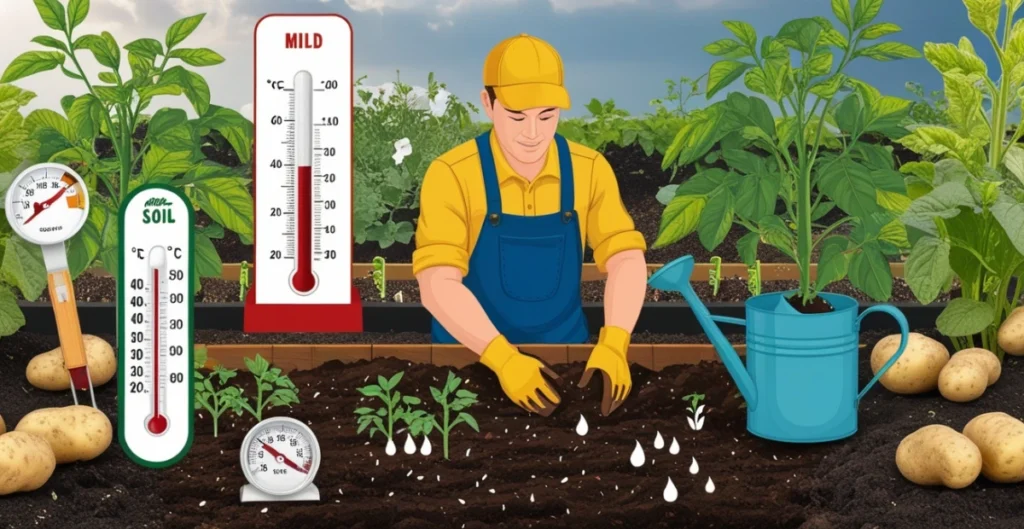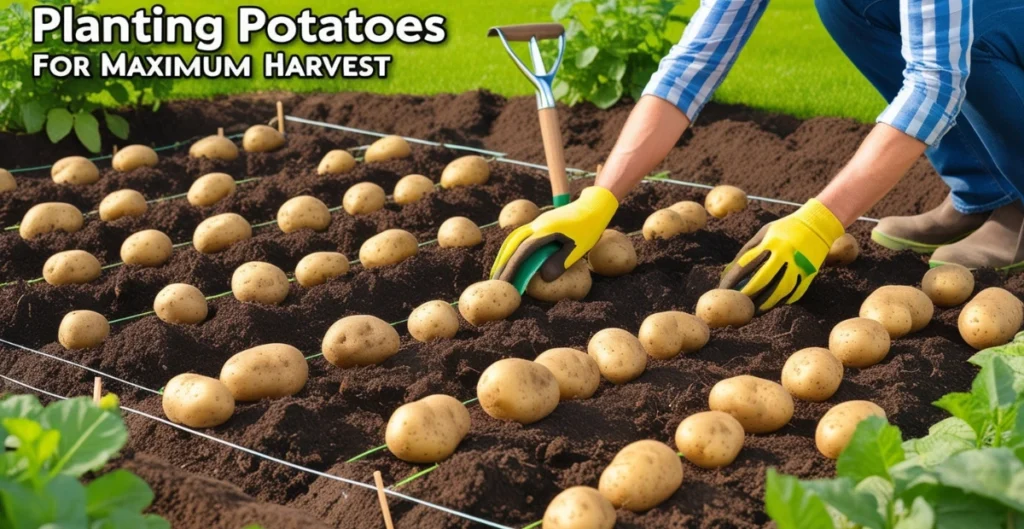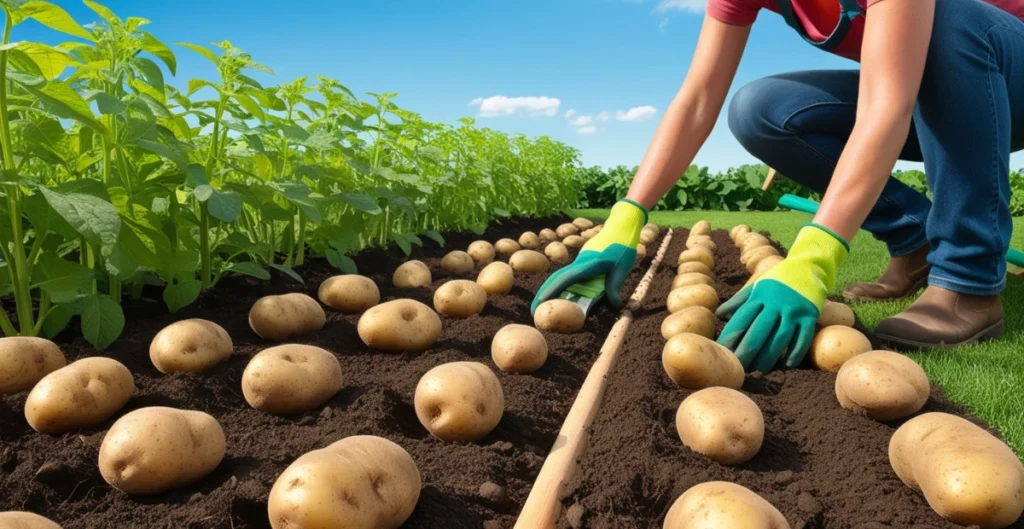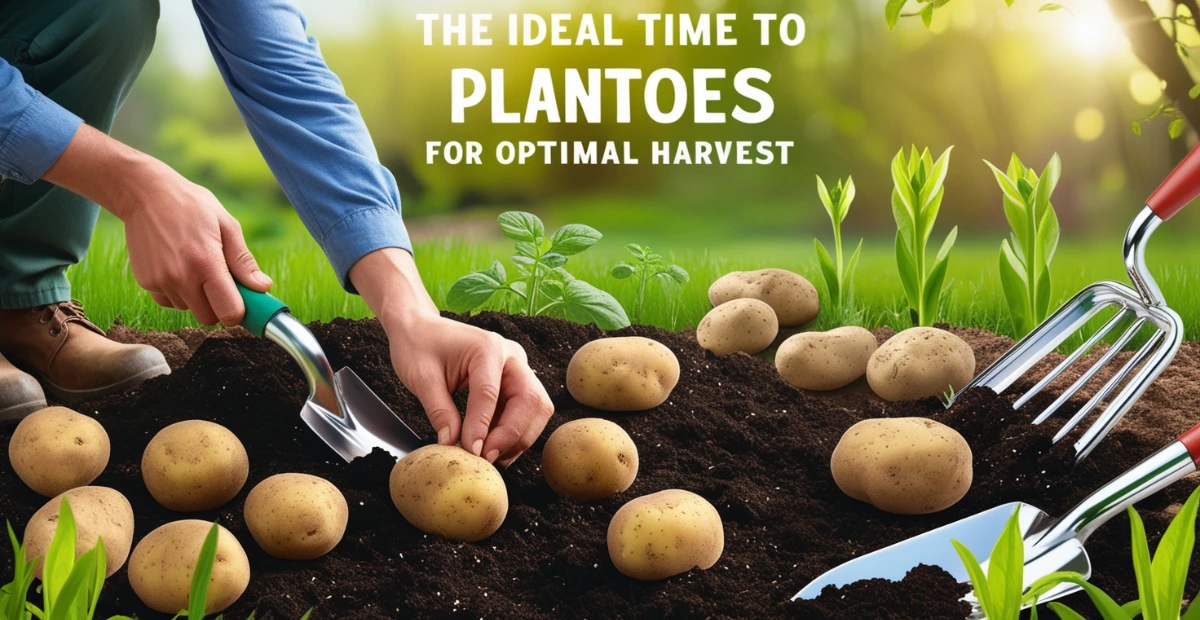Planting potatoes is one of the most satisfying activities in gardening. There’s something magical about watching those tiny seed potatoes you place into the soil transform into large, hearty tubers that you can harvest and enjoy. However, achieving an abundant potato harvest requires careful attention to timing. The key question every gardener asks is: when to plant potatoes for the best possible yield?
advertisement
In this guide, we’ll walk you through everything you need to know to plant potatoes at the right time, tailored to your specific climate, soil, and potato variety. Whether you’re a seasoned gardener or planting potatoes for the first time, the tips and strategies in this article will help you grow a thriving potato crop. Let’s get started!
Table of Contents
Understanding the Ideal Time to Plant Potatoes
advertisement

Before you begin planting, it’s important to understand why timing is crucial for potato growth. Potatoes thrive when planted at the right time in the growing season, and planting them too early or too late can drastically affect your yield. If you plant too early, your potatoes could be damaged by frost or fail to grow properly due to cold soil. On the other hand, planting too late might mean your potatoes won’t have enough time to mature before the summer heat sets in.
The Ideal Planting Window
For most regions, the ideal time to plant potatoes is when the soil temperature reaches around 40°F to 45°F (4°C to 7°C). Soil that is too cold will stunt potato growth, while soil that is too warm can lead to premature sprouting. If you’re unsure about your soil temperature, a soil thermometer can help you monitor the conditions before planting.
The Role of Frost-Free Dates
Potatoes are sensitive to frost, and you want to avoid planting them during the risk of a late frost. Ideally, plant your potatoes 2-4 weeks after the last frost date for your region. This ensures the plants won’t be harmed by sudden frost, which could damage both the foliage and the developing tubers underground.
Factors to Consider When Deciding When to Plant Potatoes

Several factors play into the decision of when to plant potatoes. Here are the most important ones:
advertisement
1. Soil Temperature
As mentioned, potatoes grow best when the soil temperature is between 40°F and 45°F. If your soil is too cold, the potatoes will struggle to establish their roots, and they may even rot before they have a chance to sprout. On the other hand, warm soil encourages early sprouting, but if it gets too warm, the plants can become stressed.
Tip: Check the temperature at least 3 inches below the surface of the soil for the most accurate reading. You can use a soil thermometer or rely on local gardening data.
2. Climate and Zone
Your local climate will also dictate the best planting time. The United States Department of Agriculture (USDA) Plant Hardiness Zone Map divides the country into various climate zones based on average annual minimum temperatures. Your zone affects when the last frost occurs, the length of the growing season, and whether you’ll need to adjust your planting time.
- Cold Climates (Zones 1-4): In cold regions, spring comes later, so plant your potatoes only once the soil has warmed and frost danger has passed, typically from April to May.
- Moderate Climates (Zones 5-7): Here, you can plant potatoes earlier in the spring, around late March to early April.
- Warm Climates (Zones 8-11): If you live in a warmer climate, you can plant potatoes in late fall to early winter (November to December), since frost isn’t as much of a concern.
3. Soil Moisture
Potatoes require moist soil to develop properly. If the soil is too dry, the potatoes will have trouble sprouting and growing. Similarly, waterlogged soil can lead to rot. Ensure your soil drains well but retains enough moisture to keep the plants hydrated.
Tip: Water your soil 1-2 weeks before planting to ensure proper moisture levels.
advertisement
Best Time of Year to Plant Potatoes for Different Climates

Knowing when to plant potatoes depends largely on where you live. Below, we outline the best planting windows based on climate zone:
Cold Climates (Zones 1-4)
In colder regions with short growing seasons, you’ll want to plant potatoes only after the last frost date. Planting too early can expose your potatoes to frost damage, which could destroy your crop. For these climates, the ideal planting window is mid to late spring.
- Best Planting Time: After the last frost date in April or May.
- Variety to Choose: Opt for early-season potato varieties like ‘New Potatoes’ or ‘Yukon Gold,’ which mature in 70-90 days.
Moderate Climates (Zones 5-7)
For gardeners in moderate climates, the growing season is a bit longer, which means you can plant potatoes earlier. You may even be able to plant your potatoes a little before the last frost date, provided you protect the plants with covers or by planting early-season varieties.
- Best Planting Time: Late March to early April.
- Variety to Choose: Try mid-season potatoes like ‘Red Bliss’ or ‘Russet Burbank.’
Warm Climates (Zones 8-11)
If you live in a warmer climate, you have the luxury of a long growing season. You can plant potatoes in late fall or early winter, which will allow you to harvest them in late winter or spring.
- Best Planting Time: Late fall (November to December).
- Variety to Choose: Late-season potatoes like ‘Fingerlings’ or ‘Purple Majesty.’
How to Prepare Your Soil for Planting Potatoes

Soil preparation is crucial to growing healthy, high-yielding potatoes. Potatoes thrive in loose, well-drained soil with a slightly acidic pH of 5.8 to 6.5.
advertisement
Steps to Prepare Your Soil
- Test Soil pH: Use a soil testing kit to determine the pH of your soil. If it’s too acidic, you can add lime to raise the pH, or add sulfur to lower it if it’s too alkaline.
- Add Organic Matter: Potatoes love nutrient-rich soil, so work in a few inches of compost or aged manure before planting. This not only improves soil fertility but also enhances drainage.
- Loosen the Soil: Potatoes need plenty of space to grow their tubers, so make sure the soil is loose and well-aerated. Use a shovel, fork, or tiller to loosen the soil to a depth of 6-8 inches.
How to Plant Potatoes for Maximum Harvest

Planting potatoes properly is key to maximizing your harvest. Here’s a step-by-step guide to ensure you’re setting your plants up for success:
Step 1: Choose Quality Seed Potatoes
Use certified seed potatoes for the best results. These potatoes are disease-free and have been inspected to ensure they meet quality standards. Avoid using grocery store potatoes, as they may carry diseases and have been treated with growth inhibitors.
Step 2: Prepare the Seed Potatoes
If your seed potatoes are large, cut them into smaller pieces, making sure each piece has at least one “eye” or bud. Allow the cut pieces to air-dry for 1-2 days to form a callus over the cut surface, which reduces the risk of rot.
Step 3: Planting Depth and Spacing
- Planting Depth: Dig a trench 4-6 inches deep.
- Spacing: Space each seed potato 12-15 inches apart to give them room to grow.
- Orientation: Place the seed potatoes with the eyes facing upward.
advertisement
Step 4: Water and Mulch
Water the soil thoroughly after planting, and cover the planted area with mulch, such as straw or leaves. Mulch helps retain moisture and suppresses weeds.
Troubleshooting Common Planting Problems

Even with the best preparation, issues can arise. Here are some common problems you might encounter when planting potatoes, along with tips on how to overcome them:
1. Frost Damage
Potatoes are sensitive to frost, which can damage the foliage and reduce your yield. To prevent frost damage, plant after the last expected frost date for your area. If you’re concerned about unexpected frosts, use row covers or cloches to protect your plants.
2. Watering Issues
Both under-watering and over-watering can affect your potato plants. Potatoes need consistent moisture, especially while the tubers are developing. Water the plants deeply once a week, and more frequently during hot spells.
3. Pest Infestations
Potato beetles, aphids, and other pests can wreak havoc on your plants. To control pests organically, consider using neem oil, diatomaceous earth, or companion planting techniques.
When to Harvest Potatoes

Potatoes are ready for harvest when the plants have flowered and the foliage begins to yellow and die back. At this stage, the potatoes have reached full size and are ready for storage.
Signs It’s Time to Harvest:
- The leaves turn yellow and begin to die back.
- The plants stop growing and start to wilt.
- The soil feels firm when you gently dig around the plant.
advertisement
Conclusion: Your Path to a Thriving Potato Harvest
Knowing when to plant potatoes is just as important as the planting process itself. By considering soil temperature, local climate, and proper planting techniques, you’ll be well on your way to a bountiful potato harvest. Whether you’re a beginner or an experienced gardener, the satisfaction of growing and harvesting your own potatoes is unmatched.
Take the time to plan carefully, prepare your soil, and select the right potato variety for your region. The effort you put in today will reward you with a delicious crop of homegrown potatoes for months to come.
Happy gardening!
Frequently Asked Questions (FAQs)
Q1: When is the best time to plant potatoes in colder climates?
- In colder climates, the best time to plant potatoes is after the last frost date, usually in late April to early May.
Q2: Can I plant potatoes in the fall for a winter harvest?
- Yes, in warmer climates (Zones 8-11), potatoes can be planted in late fall to early winter, allowing for a winter harvest.
Q3: How deep should I plant potatoes?
- Plant seed potatoes 4-6 inches deep, with the eyes facing upward.
Q4: What is the ideal soil temperature for planting potatoes?
- The ideal soil temperature for planting potatoes is between 40°F and 45°F (4°C to 7°C).


